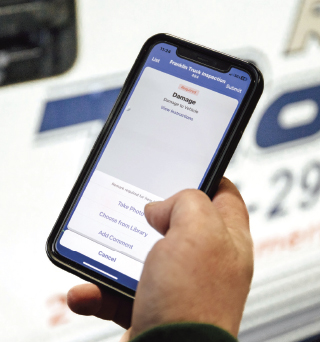When it comes to managing a fleet, embracing new technologies and solutions can be a pivotal step in optimizing operations, enhancing efficiency, and staying competitive. However, the road to successful technology adoption is not always smooth, especially when it comes to addressing driver hesitancy—one of the leading factors in the success or failure of technology implementation.
While fleet management solutions like fleet management software (FMS) provide a multitude of benefits business wide, some drivers may encounter roadblocks due to unfamiliarity with digital solutions. Let’s delve into the challenge of overcoming driver hesitancy and explore effective strategies for onboarding drivers to ensure seamless software adoption.
THE HESITANCY CHALLENGE
The digital transformation happening in the fleet industry over the past several years brings with it a spectrum of technological advancements, from telematics and GPS tracking to automated workflow and reporting, and enhanced communication tools. While these innovations offer significant advantages, some drivers may find themselves apprehensive about embracing the process changes that come with new technology adoption. Common concerns include a lack of digital skills, fear of the unknown, and the perception that technology might compromise autonomy. It’s important to nail down the source of discomfort for drivers when it comes to new software adoption, as not all drivers will have the same concerns (although there may be quite a bit of overlap).

“I feel like everybody is going to have that problem at some point,” says Matt Milacki, Transportation & Fleet Analyst, Newpark Mats, regarding driver adoption hesitancy. “I think—at least from our experience—whenever there’s change, people are going to get frustrated and kind of reject it before they even try it. But once we really dived into the benefits and saw the benefits that [FMS] has to offer, people developed that comfortableness and kind of just ran with it.”
How well you understand and mitigate your drivers’ technology adoption concerns can directly impact successful implementation. Before starting the purchasing process, fleet managers should communicate with drivers around the need for the fleet solution, potential process changes, what the company hopes to gain by adopting the solution, and what is expected of drivers when using the solution.
These topics can help surface underlying concerns your drivers may have while giving you a better idea of what to look at in a solution in order to meet fleet and user needs.
- Select user-friendly platforms. A pivotal step in overcoming driver hesitancy is selecting a solution with a user-friendly platform. Because the goal of FMS and other fleet technologies is to streamline processes, ease of use can make all the difference. User interface design, ease of navigation, and intuitive features play a vital role in making the technology widely accessible and appealing to drivers. When evaluating potential solutions, fleet managers should prioritize platforms that offer simplicity without sacrificing functionality.
- Be inclusive in the decision-making. Drivers are the backbone of any successful fleet operation, and including them in the decision-making process can be a game changer. Seek their input and feedback, address their concerns, and involve them in the software selection process to make the most of the solution you choose. This approach not only empowers drivers to take ownership of the technology but also ensures that the chosen solution aligns with their needs and tech capabilities.
- Offer comprehensive training and support. Investing in comprehensive training is an investment in successful adoption. Offer drivers hands-on training sessions that cover every aspect of the software’s functionality. These training sessions should be tailored to different skill levels and learning styles. By addressing any knowledge gaps and building confidence, drivers will be better equipped to embrace the technology with enthusiasm.

- Provide easy-to-use resources. When it comes to new technology, accessibility is key. Provide drivers with easy-to-use resources, such as user manuals, video tutorials, and FAQs. These resources should be readily available and designed in a way that drivers can quickly refer to them whenever they encounter challenges or have questions. Many fleet software companies today provide a comprehensive resource center freely available to users.
- Highlight the benefits. Adopting a software that adds stress and makes workflow more burdensome is the opposite outcome you want from fleet technology. Drivers are more likely to embrace technology when they understand how it directly benefits them. Highlight the advantages of the FMS from their perspective. Whether it’s reducing paperwork, enhancing safety, simplifying reporting, or improving communication, drivers should clearly see how the technology makes their jobs easier and more efficient.
- Cultivate a supportive environment. Creating a supportive and encouraging culture can significantly influence driver attitudes towards technology adoption. Foster an environment where drivers feel comfortable asking questions, sharing concerns, seeking assistance, and knowing their voice will be heard. This can be achieved through regular feedback sessions, open-door policies, and recognition of drivers who excel in utilizing the technology.
- Continuously Monitor Feedback. Successful onboarding is an ongoing process. Continuously monitor the software’s usage and gather feedback from drivers. Address any emerging challenges promptly and proactively. By continuously refining the onboarding process based on driver input, fleet managers can create an atmosphere of continuous improvement.
Overcoming driver hesitancy is a crucial step toward harnessing the full potential of FMS and other fleet technologies. By following the tips outlined in this article, fleet managers can pave the way for successful technology adoption for improved operational efficiency.
ABOUT THE AUTHOR
Rachael Plant is a content marketing specialist for Fleetio, a fleet management software company that helps organizations track, analyze and improve their fleet operations. For more information, visit www.fleetio.com.




